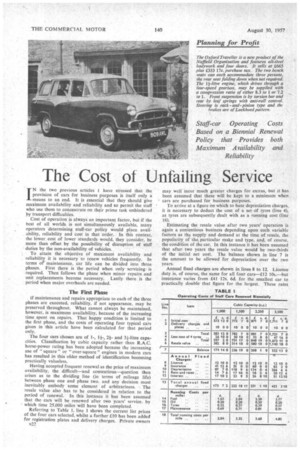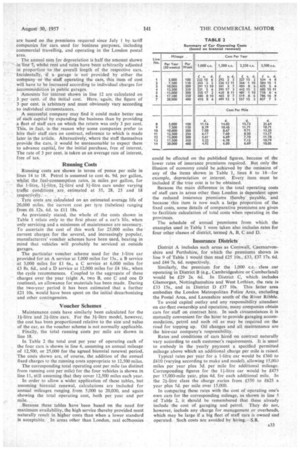The Cost of Unfailing. Service
Page 56

Page 59

If you've noticed an error in this article please click here to report it so we can fix it.
IN the two previous articles I have stressed that the provision of cars for business purposes is itself only a means to an end. It is essential that they should give maximum availability and reliability and so permit the staff who use them to concentrate on their prime task unhindered by transport difficulties.
Cost of operation is always an important factor, but if the bast of all worlds is not simultaneously available, many operators determining staff-car policy would place availability, reliability and cost in that order. In this context, the lower cost of lower standards would, they consider, be more than offset by the possibility of disruption of staff duties by the non-availability of vehicles..
To attain the objective of maximum availability and reliability it is necessary to renew vehicles frequently. In terms ott maintenance, car life can be divided into three phases. First there is the period when only servicing is • required. Then follows the phase when minor repairs and unit replacements become necessary. Lastly there is the period when major overhauls are needed.
The First Phase
If maintenance and repairs appropriate to each of the three phases are executed, reliability, if not appearance, may be preserved throughout. What cannot always be maintained, however, is maximum availability, because of the increasing time spent on repairs. That happy condition is limited to the first phase, and the costs of operating four typical cars given in this article have been calculated for that period only.
The four cars chosen are of 1-, R-, 24and 31-litre capacities. Classification by cubic capacity rather than R.A.C. horse-power rating has been adopted because the increasing use of " square " or " over-square " engines in modern cars has resulted in this older method of identification becoming practically valueless.
Having accepted frequent renewal as the price of maximum availability, the difficult—and contentious—question then arises as to the dividing line (in terms of mileage life) between phase one and phase two, and any decision must inevitably embody some element of arbitrariness. . The resale value also has to be considered in relation to the period of renewal. In this instance it has been assumed that the cars will be renewed after two years' service, by which time 25,000 miles will have been completed. Referring to Table 1, line 1 shows the current list prices of the four cars selected, whilst a further £10 has been added for registration plates and delivery charges. Private owners n22
may well incur much greater charges for extras, but it has been assumed that these will be kept to a minimum when cars are purchased for business purposes.
To arrive at a figure on which to base depreciation charges, it is necessary to deduct the cost of a set of tyres (line 4), as tyres are subsequently dealt with as a running cost (line 16).
Estimating the resale value after two years' operation is again a contentious business depending upon such variable factors as the supply and demand at the time of resale, the popularity of the, particular make and type, and, of course. the condition of the car. In this instance it has been assumed that after two years the resale value would be two-thirds of the initial net cost. The balance shown in line 7 is the amount to be allowed •for depreciation over the two years.
Annual fixed charges arc shown in lines 8 to 12. Licence duty is, of course, the same for all four cars--£12 10s.—but insurance varies from £41 12s. 6d, for the smallest car to practically double that figure for the largest. These rates are based on the premiums required since July 1 by tariff companies for cars used for business purposes, including commercial travelling, and operating in the London postal area.
The annual sum for depreciation is half the amount shown in line 7, whilst rent and rates have been arbitrarily adjusted in proportio.n to the overall length of the respective cars.
Incidentally, if a garage is notprovided by either the cotripany or the -staff operating the cars, this item of cost will have to be increased according to individual charges for accoMrnodaition-in.pnblic garages.
Amounts for interest shown in line 12 are calculated on 3.per ;cent -of the initial cost. Here,again, the figure of 3-per ant. is -arbitrary and must obviously vary according
to individual circumstances. .
A successful company may find it could make better use .
of such capital by expanding the business than by providing a fleet of staff cars on which the return was only 3 per cent.
This, in fact, is the reason why some companies prefer to hire their Staff cars on contract, reference to which is made later in the article. Alternatively, where the staff themselves provide the ears, it would be unreasonable to expectthem to advance capital, for the initial purchase, free of interest. The rate of 3 per cent, is taken as an average rate of interest, free of tax.
Running Costs Running costs are shown in terms of pence per mile in lines 14 to 18. Petrol is assumed to cost 4s. 94. per gallon, whilst the .fuel-consumption rates, .in. miles per .gallon, for the 1-litre, 21-litre and 34-litre. cars under varying traffic conditions are: estimated . at 35, 28, 25 and 18
respectively. . . Tyre costs are calculated on an estimated. average life of 20,006 miles, the 'current cost per tyre (tubeless) ranging from £6 12s. 6d. to £11 I8s.
As previously stated, the whole of the costs shown in Table 1 relate only to the first phase. of a car's life, when only servicing and a minimum of maintenance are necessary. To ascertain the cost a this work for 25,000 miles the current charges for the several, and increasingly popular, manufacturers' voucher schemes have been used, bearing in mind that vehicles will probably he serviced at outside garages.
The particular voucher scheme used for the 1-litre car provided for an A service at 1,000 miles for 13s., a B service at 3,000 miles for £1 6s., a C service at 6,000 miles for 13 8s. 6d., and a D service at 12,000 miles for 14 16s., when the cycle recommences. Coupled to the aggregate of these Charges over the year (eight A, two B, one C and one routines), an allowance for materials has been made. During the two-year period it has been estimated that a further £21 10s. would have been spent on the initial decarbonizing and other contingencies.
Voucher Schemes _ Maintenance costs have similarly been calculated for the 14-litre and 21-litre cars. For the 34-litre model, however.; the cost has been proportioned relative to the size and value of the car, as the voucher scheme is not normally applicable. . Finally, the fatal running costs per mile are shown in line 18.
In Table 2 the total cost per year of operating each of the four cars is shown in line 4, assuming an annual mileage of 12,500, or 25,000 for the agreed biennial renewal period. The costs shown are, of course, the addition of the annual fixed charges to the running costs appropriate to 12.500 mile-s.
The corresponding total operating cost per mile (as distinct from running cost per mile) for the four vehicles is shown in line 11, still assuming that they cover 12,500 miles each year.
In order to allow a wider application of these tables, but .
assuming biennial renewal, calculations arc included for annual mileages ranging from 5,000 to 20,000, and again showing the total operating cost, both per year and per mile.
.Because these tables have been based on the need for maximum availability, the high service thereby provided must naturally result in higher costs than when a lower standard is acceptable. . In areas other than London, real ecirenornies could be effected on the published figures, because of the lower rates of insurance premiums required. But only the illusion of economy could be achieved by the omission of any of the items shown in Table 1, lines 8 to 18-for example, depreciation or interest. Every item must be included if the true cost is to 'he obtained.
Because the main difference in the total operating costs of staff cars in areas other. than London is dependent upon the reduced insurance premiums thereby payable, and. because this item is now such a large proportion of the fixed costs, some details of comparative premiums are given to facilitate calculation of total costs when operating in the provinces.
The schedule of annual premiums from which the examples used in Table I were taken also includes rates for four other classes of district, termed A, B, C and D. •
Insurance Districts
District A includes such areas as Cornwall, Caernarvonshire and Perthshire, for which the premiums shown in line 9 of Table 1 would then read £25 10s., £33, £37 17s. 6d. and £44 7s. 6d. respectively.
Similarly, the premium for the 1,000 C.Q. • class .car operating in District B (e.g., Cambridgeshire or Cumberland) would be £29 2s. 6d. In District C, which. includes Glamorgan, Nottinghamshire and West Lothian, the rate is £33 15s., and in District D £37 10s. This latter area embodies the London Metropolitan Police Area, excluding the Postal Area, and Lancashire southof the River Ribble.
To avoid capital outlay and any responsibility attendant on car-fleet ownership and operation, many companies obtain cars for staff on contract hire. In such circumstances it is mutually convenient for the hirer to provide garaging accommodation, petrol and such oil as may be required on the read for topping up. Oil changes and all maintenance are the hire-car company's responsibility.
Rates and conditions of cars hired on contract naturally vary according to each customer's requirements. It is usual to embody in the yearly payment a specified permitted mileage above which an additional charge per mile is raised.
Typical rates per year for a I-litre car would be £360 to 1410 (varying according to make and model), allowing 15,000 miles per year plus 3d. per mile for additional mileage. Corresponding figures for the II-litre car would be £475 per 15,000-mile year, plus 4d. for each additional mile. In the 2*-litre class the charge varies from £550 to £625 a year plus 5d. per mile over 15,000.
In comparing these rates with the cost of operating one's own cars for the corresponding mileage, as shown in line 5 of Table 2, it should be remembered that these already include the cost of garaging and petrol. They do not, however, include any charge for management or overheads, which may be large if a big fleet of staff cars is owned and operated. Such costs are avoided by




























































































